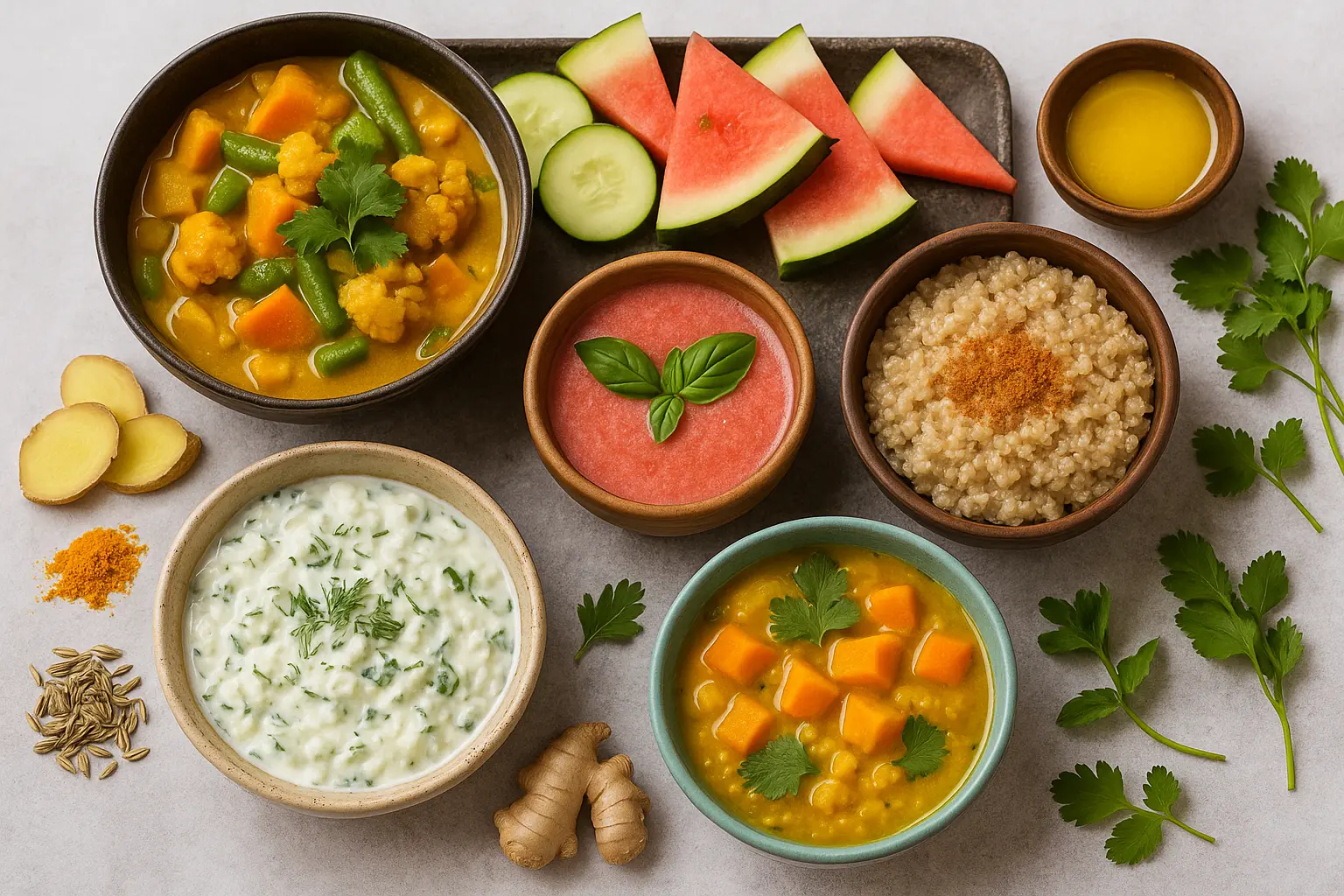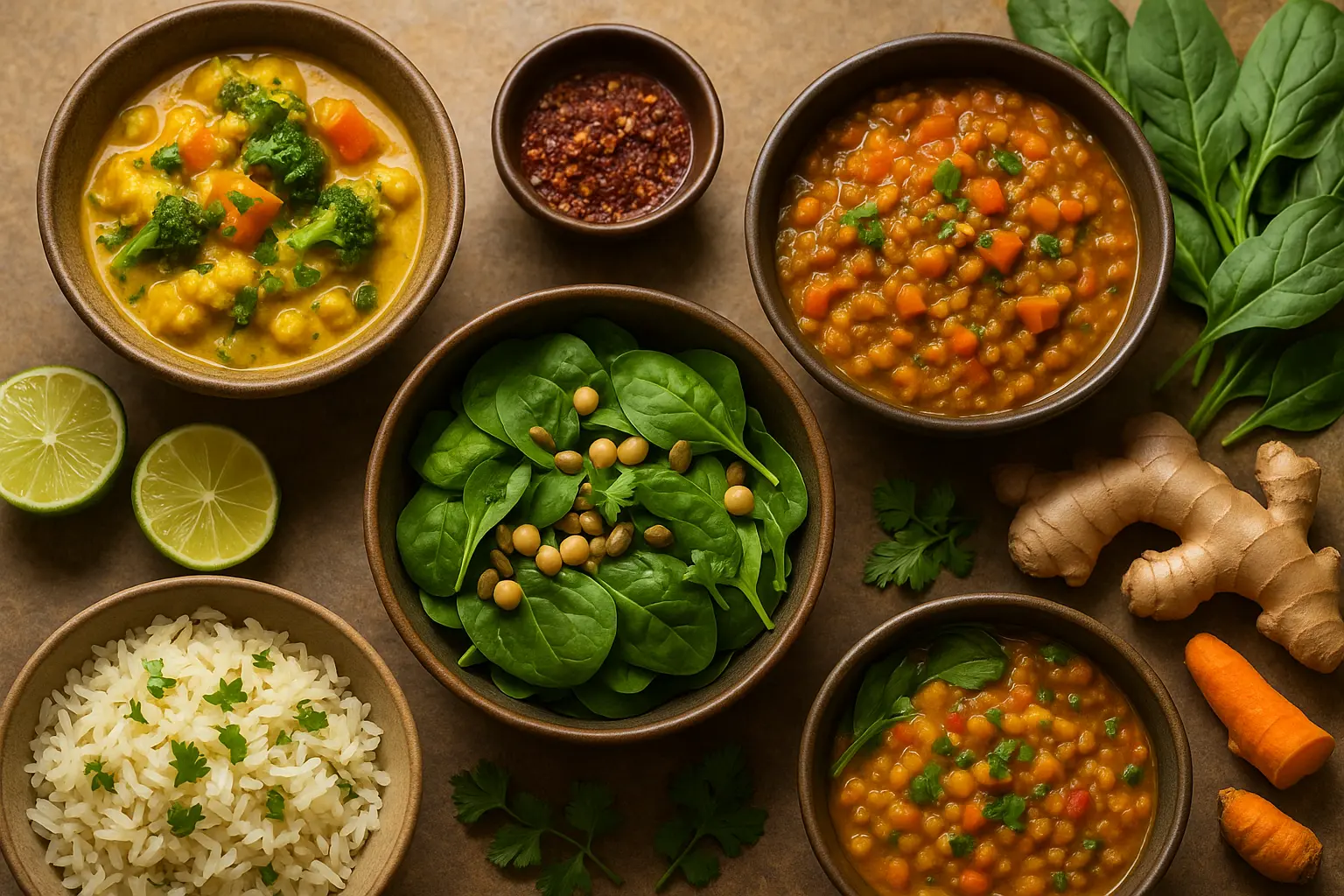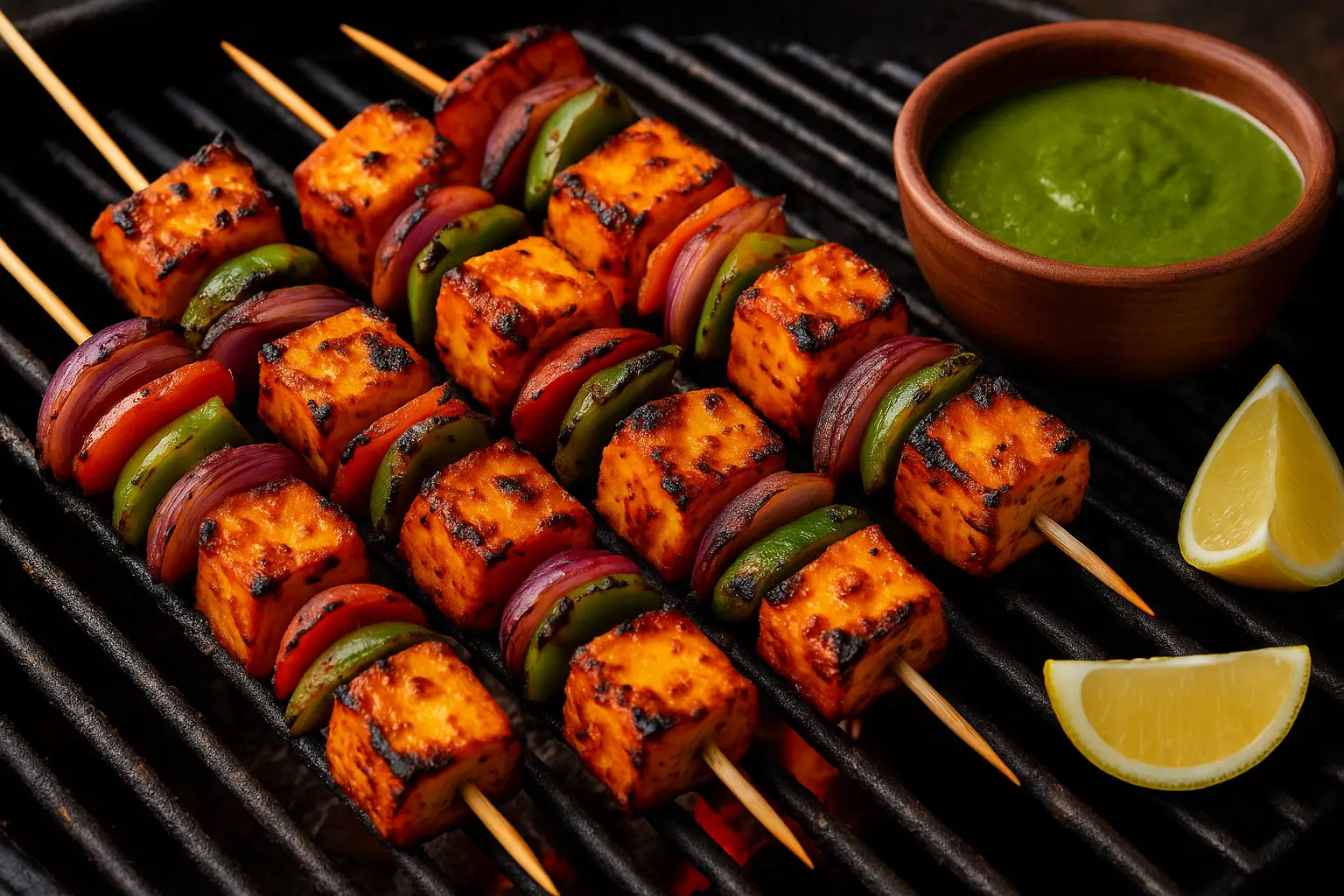Ayurveda, the ancient Indian system of holistic health, is built upon the principle that nature and the human body are deeply interconnected. Just as the seasons change, our bodies shift in response to temperature, light, and environment. The Ayurvedic approach to eating involves adjusting our diet according to these natural rhythms to maintain balance, strengthen immunity, and promote long-term well-being.
In this guide, we’ll explore how to adapt your diet for every season — summer, monsoon, autumn, and winter — with nourishing Ayurvedic recipes that are vegetarian, gluten-free, and dairy-free. These dishes are not just flavorful but also aligned with Ayurvedic wisdom to keep your body, mind, and spirit in harmony.

Understanding Ayurveda & Seasonal Balance
Ayurveda identifies three primary doshas — Vata, Pitta, and Kapha — which are biological energies governing all bodily functions. Each person has a unique combination of these doshas, but seasonal changes can increase or decrease their influence:
- Vata (Air & Space) – Dominates in autumn and early winter. Excess can cause dryness, anxiety, and coldness.
- Pitta (Fire & Water) – Peaks in summer. Excess can cause heat, inflammation, and irritability.
- Kapha (Earth & Water) – Strong in late winter and spring. Excess can cause sluggishness, heaviness, and congestion.
By choosing foods that counteract the dominant seasonal dosha, we can restore balance.
Seasonal Ayurvedic Food Principles
- Summer (Pitta Season) – Focus on cooling, hydrating foods. Favor sweet, bitter, and astringent tastes. Avoid excessive heat-producing spices.
- Monsoon (Vata-Kapha Mix) – Eat warm, lightly spiced, easily digestible meals to counter dampness and digestive sluggishness.
- Autumn (Vata Season) – Prioritize grounding, warm, oily foods. Use spices that improve digestion and circulation.
- Winter (Kapha-Vata Season) – Favor warming, nutrient-dense foods. Use immune-boosting spices and healthy fats.
Core Ayurvedic Ingredients for Balance
Regardless of the season, some Ayurvedic staples can be adapted year-round:
- Ghee or Coconut Oil – Enhances digestion and absorption of nutrients (use coconut oil for dairy-free option).
- Spices like Turmeric, Cumin, Coriander, Fennel, and Ginger – Support digestion and immunity.
- Seasonal Vegetables – Provide freshness and bioavailable nutrients.
- Legumes – Mung beans, red lentils, and chickpeas are easily digestible and protein-rich.
- Herbal Teas – Tulsi, fennel, and mint aid in detoxification and balance.
Ayurvedic Recipes by Season
1. Summer Recipes (Pitta Balancing)
Cooling Cucumber & Coconut Raita (Dairy-Free)
Serves: 2
Prep Time: 10 mins
Ingredients
- 1 large cucumber, grated
- 1 cup coconut yogurt (unsweetened)
- 1 tsp fresh mint leaves, chopped
- ½ tsp cumin powder
- Pinch of rock salt
Method
- Mix grated cucumber with coconut yogurt in a bowl.
- Add mint, cumin, and salt.
- Chill before serving with warm millet or rice dishes.
Ayurvedic Note: Coconut and cucumber are naturally cooling, making them perfect for calming Pitta heat.
Watermelon & Basil Detox Juice
Serves: 2
Prep Time: 5 mins
Ingredients
- 2 cups watermelon cubes
- 6–8 fresh basil leaves
- 1 tsp lime juice
Method
- Blend all ingredients until smooth.
- Strain if desired and serve chilled.
Ayurvedic Note: Watermelon hydrates the body and basil aids digestion in humid summer days.
2. Monsoon Recipes (Balancing Vata-Kapha)
Mung Bean & Vegetable Khichdi
Serves: 4
Prep Time: 10 mins | Cook Time: 30 mins
Ingredients
- 1 cup split yellow mung dal
- ½ cup basmati rice or quinoa
- 2 cups seasonal vegetables (carrots, zucchini, beans)
- 1 tsp cumin seeds
- ½ tsp turmeric powder
- 1 tbsp coconut oil
- 5 cups water
- Rock salt to taste
Method
- Wash mung dal and rice thoroughly.
- Heat coconut oil in a pot, add cumin seeds and turmeric.
- Add mung dal, rice, and vegetables. Stir for 2 mins.
- Add water, salt, and simmer until soft and porridge-like.
Ayurvedic Note: Khichdi is gentle on digestion, perfect for rainy days when metabolism slows.
Ginger-Tulsi Herbal Tea
Serves: 2
Prep Time: 5 mins
Ingredients
- 2 cups water
- 1 tbsp fresh ginger slices
- 6 tulsi leaves
- 1 tsp jaggery (optional)
Method
- Boil water with ginger and tulsi for 5 mins.
- Strain and sweeten with jaggery if desired.
Ayurvedic Note: Tulsi boosts immunity and ginger keeps digestion strong in damp weather.
3. Autumn Recipes (Vata Balancing)
Sweet Potato & Lentil Soup
Serves: 4
Prep Time: 15 mins | Cook Time: 25 mins
Ingredients
- 2 medium sweet potatoes, cubed
- 1 cup red lentils
- 1 tbsp coconut oil
- 1 tsp cumin powder
- 1 tsp coriander powder
- 4 cups water or vegetable broth
- Rock salt to taste
Method
- Heat coconut oil, add cumin and coriander powder.
- Add sweet potatoes and sauté 3 mins.
- Add lentils, broth, and salt. Cook until soft.
- Blend to creamy consistency if desired.
Ayurvedic Note: Sweet potatoes are grounding and lentils provide warmth — ideal for calming Vata.
Warm Spiced Almond Milk (Dairy-Free)
Serves: 2
Prep Time: 5 mins
Ingredients
- 2 cups almond milk
- ¼ tsp turmeric powder
- ¼ tsp cinnamon powder
- Pinch of nutmeg
- 1 tsp jaggery or maple syrup
Method
- Heat almond milk in a pan.
- Add turmeric, cinnamon, nutmeg, and sweetener.
- Simmer for 3 mins before serving warm.
4. Winter Recipes (Kapha-Vata Balancing)
Spiced Vegetable Stew
Serves: 4
Prep Time: 15 mins | Cook Time: 35 mins
Ingredients
- 2 carrots, chopped
- 1 cup pumpkin cubes
- 1 cup green beans
- 1 cup cauliflower florets
- 1 tbsp coconut oil
- 1 tsp turmeric powder
- 1 tsp garam masala
- 4 cups vegetable broth
Method
- Heat coconut oil, add turmeric and garam masala.
- Add all vegetables and stir for 3 mins.
- Add broth and simmer until vegetables are tender.
Cinnamon & Cardamom Quinoa Porridge
Serves: 2
Prep Time: 10 mins | Cook Time: 15 mins
Ingredients
- ½ cup quinoa
- 1 cup almond milk
- 1 cup water
- ¼ tsp cinnamon powder
- ¼ tsp cardamom powder
- 1 tsp maple syrup
Method
- Cook quinoa with water until soft.
- Add almond milk, cinnamon, cardamom, and maple syrup.
- Simmer for 3 mins before serving warm.
Tips for Cooking Ayurvedic Seasonal Recipes
- Cook Fresh Daily – Ayurveda emphasizes freshly prepared meals for maximum prana (life force).
- Use Spices Wisely – Adjust spice levels based on the season and your body’s needs.
- Eat Mindfully – Avoid distractions, chew thoroughly, and eat at regular times.
- Seasonal Produce is Key – Always choose fruits and vegetables in season for best nutrition.
Conclusion
Ayurvedic recipes for seasonal balance are not just about what you eat, but also how and when you eat. By following nature’s rhythms, using seasonal produce, and aligning your diet with your dosha needs, you can experience better digestion, immunity, and overall well-being.
These vegetarian, gluten-free, and dairy-free recipes are a starting point for year-round Ayurvedic living — simple, flavorful, and deeply nourishing for body and mind.aa
Leave a comment
Your email address will not be published. Required fields are marked *




















